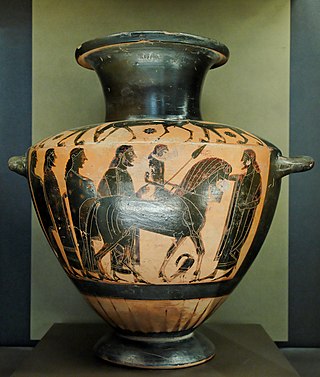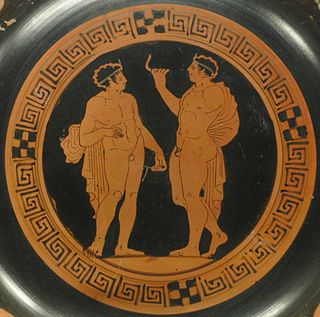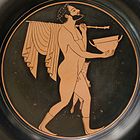
Black-figure pottery painting, also known as the black-figure style or black-figure ceramic, is one of the styles of painting on antique Greek vases. It was especially common between the 7th and 5th centuries BCE, although there are specimens dating in the 2nd century BCE. Stylistically it can be distinguished from the preceding orientalizing period and the subsequent red-figure pottery style.

Exekias was an ancient Greek vase painter and potter who was active in Athens between roughly 545 BC and 530 BC. Exekias worked mainly in the black-figure technique, which involved the painting of scenes using a clay slip that fired to black, with details created through incision. Exekias is regarded by art historians as an artistic visionary whose masterful use of incision and psychologically sensitive compositions mark him as one of the greatest of all Attic vase painters. The Andokides painter and the Lysippides Painter are thought to have been students of Exekias.

Red-figure pottery is a style of ancient Greek pottery in which the background of the pottery is painted black while the figures and details are left in the natural red or orange color of the clay.

Lydos was an Attic vase painter in the black-figure style. Active between about 560 and 540 BC, he was the main representative of the "Lydos Group". His signature, ό Λυδός, ho Lydos, inscribed on two vases, is informative regarding the cultural background of the artist. Either he immigrated to Athens from the Lydian Empire of King Kroisos, or he was born in Athens as the son of Lydian parents. In any case, he learned his trade in Athens.

Psiax was an Attic vase painter of the transitional period between the black-figure and red-figure styles. His works date to circa 525 to 505 BC and comprise about 60 surviving vases, two of which bear his signature. Initially he was allocated the name "Menon Painter" by John Beazley. Only later was it realised that the artist was identical with the painters signing as "Psiax".

The Pioneer Group is a term used by scholars for a number of vase painters working in the potters' quarter of Kerameikos in ancient Athens around the beginning of the 5th century BC, around the time of the emergence of red-figure vase painting, which soon displaced the previously dominant black-figure style.

The Brygos Painter was an ancient Greek Attic red-figure vase painter of the Late Archaic period. Together with Onesimos, Douris and Makron, he is among the most important cup painters of his time. He was active in the first third of the 5th century BCE, especially in the 480s and 470s BCE. He was a prolific artist to whom over two hundred vases have been attributed, but he is perhaps best known for the Brygos Cup, a red-figure kylix in the Louvre which depicts the "iliupersis" or sack of Troy.

The Kerch style, also referred to as Kerch vases, is an archaeological term describing vases from the final phase of Attic red-figure pottery production. Their exact chronology remains problematic, but they are generally assumed to have been produced roughly between 375 and 330/20 BC. The style is characterized by slender mannered figures and a polychromatism given to it by the use of white paint and gilding.

The Providence Painter is the conventional name given to a painter of the Attic red-figure style. He was active around 470 BC.

The Meleager Painter was an ancient Greek vase painter of the Attic red-figure style. He was active in the first third of the 4th century BC. The Meleager Painter followed a tradition started by a group of slightly earlier artists, such as the Mikion Painter. He is probably the most important painter of his generation. He painted a wide variety of vase shapes, including even kylikes, a rarity among his contemporaries.
The YZ Group is an assumed group of ancient Greek Attic vase painters of the red-figure style.

The Foundry Painter was an ancient Greek Attic red-figure vase painter of the Late Archaic period. His real name is unknown; the conventional name is derived from his most famous work, the Berlin Foundry Cup.

The N Painter was an Attic black-figure vase painter of the third quarter of the 6th century BC. His real name remains unknown.

Eye-cup is the term describing a specific cup type in ancient Greek pottery, distinguished by pairs of eyes painted on the external surface.

A Siana cup is a type of Attic cup decorated in the black-figure technique. They are named after one of their find locations, the Necropolis of the ancient city of Siana on Rhodes. During the second quarter of the 6th century BC, Siana cups were the predominant cup shape in Athens. The shape remained popular later and was still being produced in large quantities during the era of the Little-Master cups.

Pamphaios was an Attic potter active around the end of the 6th century BC. Pamphaios was the successor of Nikosthenes in that artist's workshop, and thus took over from one of the most influential and creative potters of antiquity. He probably took over the workshop before 510 BC and continued the tradition of his predecessor by producing typical shapes the latter had developed, such as the Nikosthenic amphora, the Nikosthenic pyxis or the Chalkidian style cup. At times, he developed these shapes further. Unlike Nikostehenes, Pamphaios favoured painters of the red-figure style, which was at the time replacing the previously dominant technique of black-figure vase painting. He also continued to employ many of the painters that had worked for Nikosthenes, such as Oltos, Epiktetos and the Nikosthenes Painter.

The Rycroft Painter was an Attic late black-figure vase painter, active in the final decade of the sixth century BC. His real name is not known.

The term Class of Cabinet des Médailles 218, or Class of Cab. Méd. 218 or Class of C.M. 218 describes both a group of Attic black-figure vase painters, and a type of vase they produced. They belong to the final third of the sixth century BC.

Skythes was an Attic black-figure and red-figure vase painter active between about 520 and 505 BC.

The Brygos Cup of Würzburg is an Attic red-figure kylix from about 480 BC. It was made by the Brygos potter and painted by the man known as the Brygos Painter. It depicts some of the best-known images of ancient Greek pottery.






















